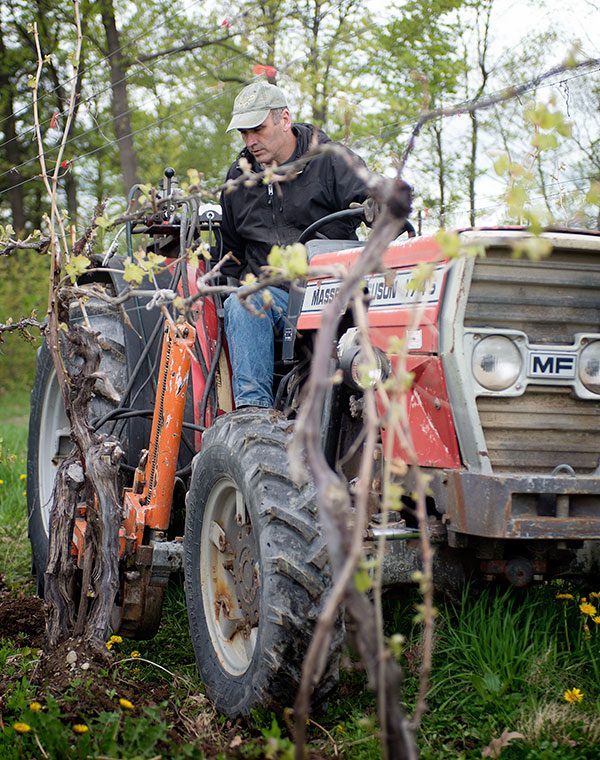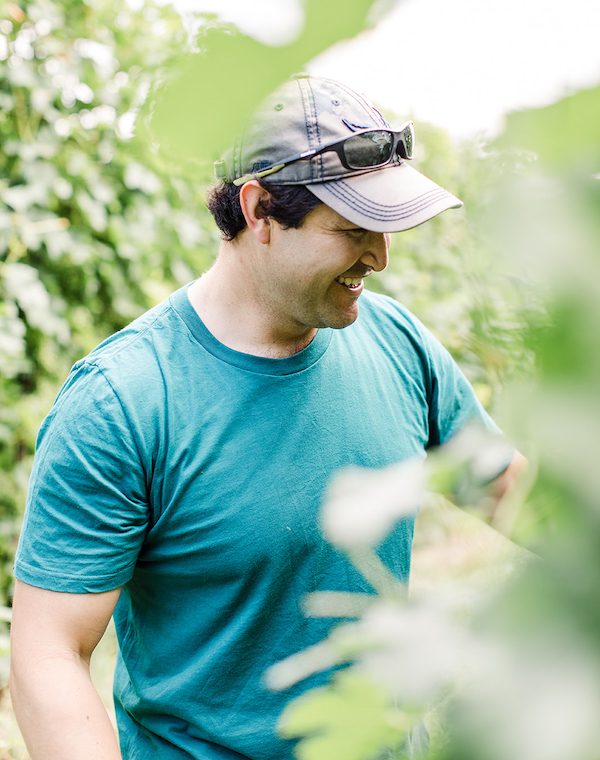
Dave Breeden
Winemaker
With experience developed in wineries throughout the Finger Lakes, Dave can always be found in our winery or lab, gently and patiently tending to the fermentation and aging of our wines while caring for our tanks, barrels, and equipment. Armed with two degrees in chemistry and two in philosophy, Dave not only brings us expertise in the wine lab and on the crush pad, but he can also be heard waxing poetic on everything from Plato’s cave to contemporary third-party politics. Dave joined the Sheldrake Point team in June, 2002.

Dave Wiemann
Vineyard Manager
Dave’s background includes four years of grapevine management at Cornell AgriTech (formerly the New York State Agricultural Experiment Station) in Geneva and two years of honeybee research in Ithaca. His love of our vineyard is second only to that for his own farm across the lake. Dave and his vineyard crew take great pride in tending the 55 acres of vines at Sheldrake Point, maintaining the equipment, and planning and preparing for new acreage. Dave joined the Sheldrake Point team in March, 1999.

José Aguilera
Assistant Vineyard Manager
Hailing from Michoacan, Mexico, José quickly became Dave’s right-hand man in tending the vineyards and assisting with the operation and maintenance of our tractors and field equipment. Fluent in both Spanish and English, José is an important link with our other vineyard workers, many of whom also come from Mexico. José joined the Sheldrake Point team in May, 2012.

Kathleen Francisco
Business Manager
Kathleen pursued her master's degree in business at Ithaca College before delving into roles in business consulting and collegiate administration. During her graduate studies, she balanced her academic pursuits with weekend work in the Tasting Room. Here, she discovered a passion for connecting with individuals in the wine industry and honing her skills in wine tasting. Kathleen's love for wine extends beyond her upstate New York roots, as she enjoys traveling internationally to explore various wine regions. Kathleen joined the Sheldrake Point team in September, 2017.

Shawn Creswell
Tasting Room Manager
Born and raised in Ovid, Shawn is a long-time staple of Sheldrake Point's Tasting Room. What began as an easy-going weekend job, pouring wine tastings at the bar while simultaneously working at a local auto paint shop, evolved into a passion for exploring diverse foods and beverages. In 2023, when the Tasting Room Manager position opened, it was only natural that Shawn became the first choice to take over operations. Shawn joined the Sheldrake Point team in September, 2016.

Samuel Ehrenreich
Assistant Winemaker
With nearly two decades of experience in the beverage and hospitality world, Sam brings a rich blend of passion, technical knowledge, and hands-on creativity to Sheldrake Point Winery. A Syracuse native, he has built his expertise through a wide range of roles in restaurants, bars, and wine retail across Metro and Central New York.
Sam’s understanding of wine goes far beyond the glass. A dedicated craft beverage enthusiast, he has made his own wine, cider, and beer — a curiosity and skill set that naturally elevates every guest experience he leads. His depth of knowledge and warm hosting style make him a standout guide for our library wine tastings in the Vintage Room.
Since joining the Sheldrake Point team in May 2023, Sam has consistently demonstrated exceptional commitment and talent. We are thrilled to celebrate his growth and welcome him into his new role as Assistant Winemaker.

Dean & Michele Babich
Owners & Managing Partners
After two years of searching for the perfect place, Michele and Dean found their home at Sheldrake Point Winery. With backgrounds in the medical field, their careers were built on care and connection—values that now shape their approach to hospitality. With their love of service and desire to create meaningful experiences, they hope to make every visit to the winery feel welcoming and special. They believe great wine is best enjoyed with great company and want guests to share in the beauty and warmth of Sheldrake Point. Dean and Michele have owned the winery since April 2025.

Chuck Tauck & Fran Littin
Co-Founders & Former Owners
Chuck and Fran joined a group of wine enthusiasts back in 1997 as the vineyard and winery were just getting started. For the next 28 years, they stewarded the evolution of the farm, the vineyard, the waterfront, and the many buildings and systems that make up the Sheldrake Point Winery of today. They sold the farm and winery to Dean and Michele Babich in the spring of 2025 and are retiring to their new home in New England.












